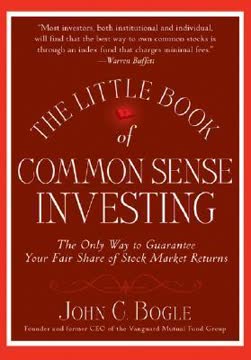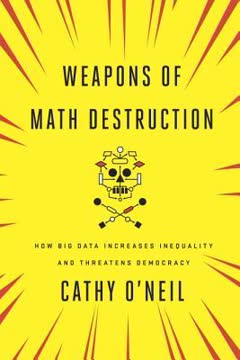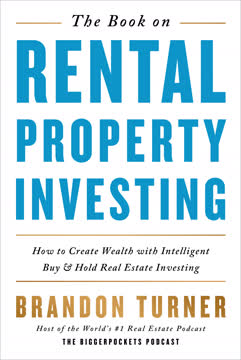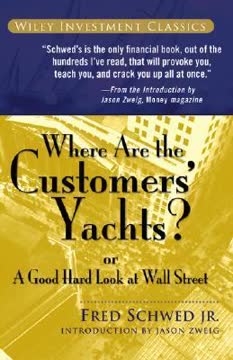Key Takeaways
1. Embrace simplicity: Low-cost index funds beat Wall Street
"10 − 2 = 8"
Simple arithmetic wins. This equation illustrates that when the market returns 10%, but you pay 2% in fees, you're left with only 8%. Low-cost index funds, which typically charge around 0.2% in fees, allow investors to keep more of their returns.
Index funds outperform. By owning the entire market at low cost, index funds consistently beat the majority of actively managed funds over the long term. This is due to lower fees, broader diversification, and reduced trading costs.
- Vanguard Total Stock Market Index Fund (VTSMX)
- Vanguard Total International Stock Index Fund (VGTSX)
- Vanguard Total Bond Market Index Fund (VBMFX)
These three funds can form the core of a simple, effective portfolio that outperforms most professional investors.
2. Diversify globally: Own the entire world market
"Don't put all of your eggs in one basket"
Global diversification reduces risk. By investing in both U.S. and international markets, investors can reduce their exposure to country-specific risks and benefit from global economic growth.
Own everything. A truly diversified portfolio should include:
- U.S. stocks (large, mid, and small-cap)
- International stocks (developed and emerging markets)
- Bonds (government and corporate)
This approach ensures you're not overly concentrated in any single country, sector, or company. It also means you'll always own the next big winner, wherever it may emerge from.
3. Control costs: You get what you don't pay for
"Every dollar of costs you are paying, whether you are seeing it or not, is handing off your wealth to somebody else."
Fees compound negatively. High investment costs, including management fees, transaction costs, and taxes, can significantly erode returns over time. Even small differences in fees can result in huge differences in wealth accumulation over decades.
Seek the lowest costs possible:
- Choose index funds with expense ratios below 0.2%
- Minimize trading to reduce transaction costs and taxes
- Avoid high-fee products like actively managed funds, annuities, and whole life insurance
By focusing on costs, investors can keep more of their returns and significantly improve their long-term outcomes.
4. Stay the course: Avoid emotional investing decisions
"Be fearful when others are greedy and greedy when others are fearful."
Emotions hurt returns. Most investors underperform the market due to emotional decision-making, such as buying high during bull markets and selling low during bear markets. This behavior gap can cost investors 1.5% or more in annual returns.
Strategies to stay rational:
- Set an asset allocation and stick to it
- Rebalance periodically to maintain your target allocation
- Avoid watching financial news and checking your portfolio frequently
- Remember that short-term market movements are unpredictable
By staying disciplined and avoiding emotional reactions to market swings, investors can capture the long-term returns the market offers.
5. Asset allocation: Balance risk and return based on your needs
"Don't bet your lunch money"
Risk tolerance is personal. The right asset allocation depends on your willingness and need to take risk. Consider both your emotional capacity to handle market volatility and your financial capacity to withstand losses.
Factors to consider:
- Time horizon: Longer time horizons allow for more stock exposure
- Financial goals: Higher return needs may require more risk
- Income stability: Stable income allows for more risk-taking
- Net worth: Higher net worth can support more risk
A common starting point is subtracting your age from 100 to determine your stock allocation, with the remainder in bonds. Adjust based on your personal circumstances and risk tolerance.
6. Tax efficiency: Minimize taxes through smart asset location
"Asset location, location, location"
Strategic asset placement saves taxes. By placing tax-inefficient investments (like bonds) in tax-advantaged accounts (like IRAs) and tax-efficient investments (like stock index funds) in taxable accounts, investors can significantly reduce their tax burden.
Tax-efficient investing strategies:
- Hold broad stock index funds in taxable accounts
- Keep bonds, REITs, and high-turnover funds in tax-advantaged accounts
- Utilize tax-loss harvesting in taxable accounts
- Consider municipal bonds for high-tax bracket investors
Proper asset location can add 0.25% to 0.75% in annual after-tax returns without increasing risk.
7. Beware of complexity: Avoid products you don't understand
"If you can't explain it simply, you don't understand it well enough."
Complexity often hides high costs. Many complex financial products, such as variable annuities, structured products, and hedge funds, come with high fees and hidden risks. If you can't explain how an investment works to a child, it's probably best to avoid it.
Red flags for complex products:
- High fees or commissions
- Lack of transparency
- Complicated terms or conditions
- Promises of high returns with low risk
Stick to simple, transparent investments that you fully understand. This approach helps avoid costly mistakes and reduces the risk of falling for financial scams.
8. Harness inertia: Set it and forget it for long-term success
"An object at rest tends to stay at rest, and that an object in uniform motion tends to stay in uniform motion."
Automate good behavior. By setting up automatic investments and rebalancing, investors can harness the power of inertia to stay on track with their investment plan. This reduces the temptation to make impulsive changes based on market movements or emotions.
Set-it-and-forget-it strategies:
- Use target-date funds or robo-advisors for automatic rebalancing
- Set up automatic contributions to investment accounts
- Implement a systematic rebalancing schedule (e.g., annually)
- Avoid frequent portfolio checking or tinkering
By leveraging inertia, investors can maintain a disciplined approach and avoid costly mistakes over the long term.
9. Pick low-hanging fruit: Optimize readily available opportunities
"If you pick the low-hanging fruit, you don't have to climb the tree"
Easy wins add up. There are often simple, low-risk ways to improve investment returns or reduce costs that many investors overlook. These "low-hanging fruit" opportunities can significantly impact long-term wealth accumulation.
Common low-hanging fruit:
- Maximize employer 401(k) match
- Use high-yield savings accounts for cash reserves
- Refinance high-interest debt
- Take advantage of tax-advantaged accounts (IRAs, HSAs)
- Shop around for lower insurance premiums
By focusing on these easy wins, investors can boost their returns without taking on additional risk or complexity.
10. Keep it simple: Brilliance lies in simplicity, not complexity
"Truth is ever to be found in simplicity, and not in the multiplicity and confusion of things."
Simple strategies work. The most effective investment approaches are often the simplest. A portfolio of low-cost index funds, properly diversified and regularly rebalanced, can outperform most complex strategies over the long term.
Benefits of simplicity:
- Lower costs
- Easier to understand and stick with
- Reduced chances of mistakes
- More time to focus on other aspects of life
By embracing simplicity in investing, individuals can achieve better outcomes while reducing stress and complexity in their financial lives. Remember, if a second-grader can understand it, it's probably a good investment strategy.
Last updated:
FAQ
What's How a Second Grader Beats Wall Street about?
- Simple Investing Principles: The book demonstrates that basic investing principles can outperform complex Wall Street strategies. It uses the author's son, Kevin, as an example to show that even a child can succeed in investing by following simple rules.
- Focus on Costs: A major theme is the importance of keeping investment costs low. High fees can significantly reduce returns, so the author advocates for low-cost index funds.
- Behavioral Finance Insights: The book explores common psychological pitfalls like fear, greed, and overconfidence, which often lead to poor investment decisions.
Why should I read How a Second Grader Beats Wall Street?
- Accessible Financial Education: The book simplifies complex financial concepts, making them understandable for readers of all backgrounds. It empowers individuals to manage their financial futures without needing a finance degree.
- Real-Life Examples: The author uses relatable anecdotes, particularly involving his son, to illustrate key points, making the lessons memorable and engaging.
- Proven Strategies: Readers will learn effective investment strategies that have been shown to outperform many traditional methods, providing a clear roadmap for building a successful investment portfolio.
What are the key takeaways of How a Second Grader Beats Wall Street?
- Investing is Simple: Successful investing doesn't have to be complicated. By following basic principles like diversification and low costs, anyone can achieve financial success.
- Avoid High Fees: Minimizing investment fees is crucial. High fees can significantly erode returns over time, so choosing low-cost options is essential.
- Long-Term Perspective: A long-term investment strategy is key. Staying invested through market fluctuations helps achieve financial goals.
What are the best quotes from How a Second Grader Beats Wall Street and what do they mean?
- “10 − 2 = 8”: This quote highlights the importance of understanding investment costs. High fees reduce the returns investors actually receive, emphasizing the need for low-cost options.
- “Paying Wall Street is a loser’s game”: This statement critiques the traditional financial industry, suggesting that expensive financial advisors often lead to poorer outcomes.
- “Common sense isn’t all that common”: This reflects the author's belief that many investors overlook basic principles due to emotional biases and misinformation.
How does the second grader's portfolio outperform Wall Street?
- Diversification Across Asset Classes: Kevin's portfolio includes a mix of U.S. stocks, international stocks, and bonds, reducing risk and improving returns.
- Low-Cost Index Funds: The portfolio uses low-cost index funds, which have historically outperformed actively managed funds due to lower fees.
- Long-Term Investment Strategy: By maintaining a long-term perspective and avoiding emotional reactions, the portfolio is designed to weather market volatility.
What are the behavioral finance concepts discussed in How a Second Grader Beats Wall Street?
- Fear and Greed: These emotions can lead investors to buy high and sell low, harming financial outcomes. Recognizing these feelings is crucial.
- Overconfidence Bias: Many investors believe they can outperform the market, leading to excessive trading and poor decisions.
- Confirmation Bias: Investors often seek information that supports their beliefs, ignoring contradictory evidence, which can lead to poor decisions.
How can I apply the lessons from How a Second Grader Beats Wall Street to my own investing?
- Focus on Low Costs: Evaluate the fees associated with your investments and transition to low-cost index funds to maximize returns.
- Diversify Your Portfolio: Spread investments across different asset classes, including U.S. stocks, international stocks, and bonds.
- Adopt a Long-Term Mindset: Commit to a long-term strategy and avoid reacting to short-term market fluctuations.
What is the second grader's portfolio composition?
- 60% U.S. Stock Index Fund: This portion allows for broad exposure to the U.S. stock market, capturing the performance of various companies.
- 30% International Stock Index Fund: This allocation provides diversification by investing in global markets.
- 10% Total Bond Market Index Fund: Including bonds helps stabilize the portfolio and reduce overall volatility.
How does Allan S. Roth suggest we avoid common investing mistakes?
- Understand Your Costs: Know what you are paying for your investments and ask for a clear breakdown of all fees.
- Stay Informed but Skeptical: Be cautious of financial media and marketing that may create illusions about investment performance.
- Stick to Your Strategy: Develop a clear investment strategy and adhere to it, even during market volatility.
What alternatives to the second grader's portfolio does Allan S. Roth discuss?
- Real Estate Investment Trusts (REITs): Adding a small percentage of REITs can enhance diversification and provide exposure to the real estate market.
- Precious Metals and Mining Stocks: These can provide a hedge against inflation but are volatile, so caution is advised.
- Alternative Asset Classes: Exploring other asset classes like commodities or emerging markets can offer diversification benefits.
How does How a Second Grader Beats Wall Street address emotional investing?
- Emotional Control: Emotions can lead to poor decisions, such as panic selling. A rational approach is encouraged.
- Behavioral Biases: Understanding biases like overconfidence and loss aversion can help improve decision-making.
- Staying the Course: A disciplined strategy focused on long-term goals is emphasized over reacting to short-term market movements.
What is the role of costs in investing according to How a Second Grader Beats Wall Street?
- Impact on Returns: High fees can significantly erode returns over time. Low-cost index funds often outperform higher-cost counterparts.
- Cost Efficiency: Choosing investments with low expense ratios is crucial for maximizing net returns.
- Tax Efficiency: Tax-efficient investments can further enhance returns, so both costs and taxes should be considered.
Review Summary
How a Second Grader Beats Wall Street receives mostly positive reviews, praised for its simple, accessible approach to investing. Readers appreciate the author's storytelling and clear explanations of complex concepts. The book advocates for a passive investment strategy using low-cost index funds, which many find revolutionary and practical. Some critics find it repetitive or oversimplified, but most agree it's an excellent introduction to investing for beginners. The book's core message of keeping investments simple and focusing on long-term goals resonates with many readers.
Similar Books










Download PDF
Download EPUB
.epub digital book format is ideal for reading ebooks on phones, tablets, and e-readers.




